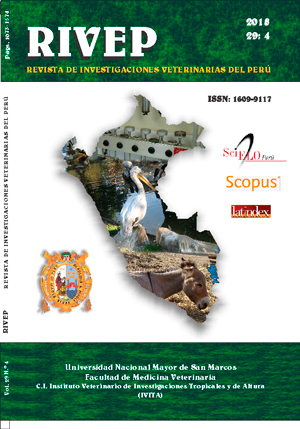Isolation of bacteriocinogenic Enterococcus mundtii strain from Hemiodema spectabilis (sea cucumber)
DOI:
https://doi.org/10.15381/rivep.v29i4.15201Keywords:
Enterococcus, mundticin, marine environment, PatagonianAbstract
This study was conducted to evaluate the antibacterial activity of a bacteriocinproducing Enterococcus mundtii tw278 strain isolated from the intestinal content of Hemiodema spectabilis (sea cucumber) sampled in the Patagonian coast of Argentine. The strain was identified by biochemical tests and 16S rRNA gene phylogenetic analyses. The structural gene that codifies mundticin KS was detected by PCR. Investigation of virulence factors revealed that E. mundtii tw278 did not display gelatinase or hemolytic activity and was susceptible to all antibiotics assayed, except cefalotin. Maximum inhibitory activity was achieved at the end of logarithmic phase when MRS broth was used as culture media at 35 °C. After 12 h of incubation, cell-free supernatant (CFS) reached a titre of 163 840 arbitrary units per mililitre against the target bacteria Listeria innocua ATCC 33090. CFS showed activity against all the Listeria strains assayed, Enterococcus faecalis ATCC 29212, vancomycin-resistant enterococci (Van A, Van B and Van C), Lactobacillus plantarum TwLb 5 and Vibrio anguilarum V10. This would be the first study to report the isolation of a bacteriocinogenic E. mundtii strain from intestinal content of Hemiodema spectabilis.Downloads
Downloads
Published
Issue
Section
License
Copyright (c) 2018 Marisol Vallejo, Franco M. Sosa, Romina B. Parada, Luis F. Aguirre, Emilio R. Marguet

This work is licensed under a Creative Commons Attribution-NonCommercial-ShareAlike 4.0 International License.
AUTHORS RETAIN THEIR RIGHTS:
a. Authors retain their trade mark rights and patent, and also on any process or procedure described in the article.
b. Authors retain their right to share, copy, distribute, perform and publicly communicate their article (eg, to place their article in an institutional repository or publish it in a book), with an acknowledgment of its initial publication in the Revista de Investigaciones Veterinarias del Perú (RIVEP).
c. Authors retain theirs right to make a subsequent publication of their work, to use the article or any part thereof (eg a compilation of his papers, lecture notes, thesis, or a book), always indicating the source of publication (the originator of the work, journal, volume, number and date).



